an interview with fine art photographer Laurie Tümer about her illuminating body of work
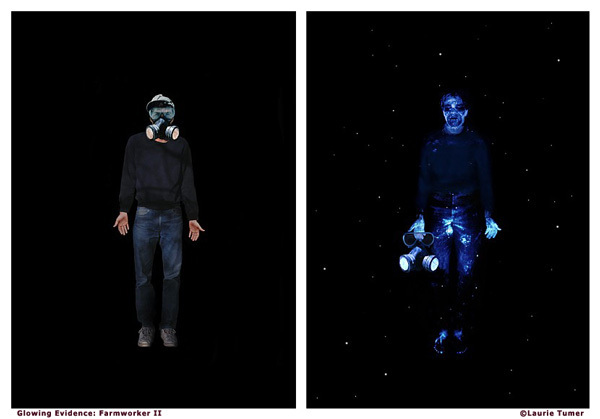
images from “Glowing Evidence” series
Photographer Laurie Tümer has been living with environmental sensitivities for seventeen years. Included in her history is exposure – and subsequent sensitization – to synthetic pesticides, fungicides, and other neurotoxic chemicals. Several years into her illness, she decided to use her artistic vision to help cultivate awareness about these invisible toxins that are ruining our health by using an innovative technique that shows how pesticides are tracked into our homes and onto our bodies. These photographs are part of a project she calls “Glowing Evidence.” Julie Genser, founder of PlanetThrive.com and a former fine art photographer herself, sits down for a virtual chat with Laurie to find out more about the process behind this unique project.
 Julie Genser: Laurie, I love the concept behind your series “Glowing Evidence.” Can you share with our readers more about the technique you used to make these photographs, and what your intention was?
Julie Genser: Laurie, I love the concept behind your series “Glowing Evidence.” Can you share with our readers more about the technique you used to make these photographs, and what your intention was?
 Laurie Tümer: In 1998, about 6 years after I became environmentally sensitive, I was living in the first house I owned. I noticed swarms of what looked like termites entering an outside crack in the wall to the kitchen and I looked in the Yellow Pages and found a company that advertised using “Organic Pest Control.” They still do. I told them I had a sensitivity to pesticides and asked what could they could do that would be non-toxic. They said they would apply a crushed chrysanthemum on the outside and assured me that it was organic and very safe. Soon after they sprayed, I became ill. It turned out they had sprayed a synthetic form of the chrysanthemum. In a hospital emergency room, the physician who saw me said this was a very common pesticide poisoning and that he had seen it many times as a doctor when he worked in a rural farming area. The acute reaction lasted many weeks and the recovery many more months.
Laurie Tümer: In 1998, about 6 years after I became environmentally sensitive, I was living in the first house I owned. I noticed swarms of what looked like termites entering an outside crack in the wall to the kitchen and I looked in the Yellow Pages and found a company that advertised using “Organic Pest Control.” They still do. I told them I had a sensitivity to pesticides and asked what could they could do that would be non-toxic. They said they would apply a crushed chrysanthemum on the outside and assured me that it was organic and very safe. Soon after they sprayed, I became ill. It turned out they had sprayed a synthetic form of the chrysanthemum. In a hospital emergency room, the physician who saw me said this was a very common pesticide poisoning and that he had seen it many times as a doctor when he worked in a rural farming area. The acute reaction lasted many weeks and the recovery many more months.
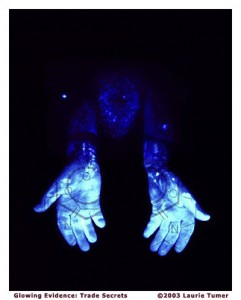 As I was convalescing, I revisited Rachel Carson’s Silent Spring. I wondered if her cautionary tale would have been and could be fully heeded if the invisible that she spoke of could be made visible in pictures, especially ones that would be commensurate with her text and her literary merging of science and poetry. To attempt this, I found a muse in the environmental scientist Richard Fenske and his surprising research photographs. Dr. Fenske’s photographs are made in safety trainings for and of farm workers who use pesticides. The objective is for workers to become more cautious using these chemicals and motivated to adhere to rigorous clean up after they leave the farm; the photographs are extremely effective. Using a non-toxic technique involving fluorescent tracer dyes and black light, workers see pictures of themselves that illustrate that pesticides do not just hit their target, but settle on their bodies, even under their protective gear. The images are a theatrical spectacle that chart the movement and settling of these chemicals and have a quality that is arresting as they can amuse, surprise, and even delight.
As I was convalescing, I revisited Rachel Carson’s Silent Spring. I wondered if her cautionary tale would have been and could be fully heeded if the invisible that she spoke of could be made visible in pictures, especially ones that would be commensurate with her text and her literary merging of science and poetry. To attempt this, I found a muse in the environmental scientist Richard Fenske and his surprising research photographs. Dr. Fenske’s photographs are made in safety trainings for and of farm workers who use pesticides. The objective is for workers to become more cautious using these chemicals and motivated to adhere to rigorous clean up after they leave the farm; the photographs are extremely effective. Using a non-toxic technique involving fluorescent tracer dyes and black light, workers see pictures of themselves that illustrate that pesticides do not just hit their target, but settle on their bodies, even under their protective gear. The images are a theatrical spectacle that chart the movement and settling of these chemicals and have a quality that is arresting as they can amuse, surprise, and even delight.
With support from Dr. Fenske and his colleagues, I learned to apply this tracer technique closer to home, where the same chemicals used in agriculture are regularly used in stores and schools are brought home on our food and shoes, and are found in the fibers of our clothes. I now can chart the ubiquitous migration and settling of these industrial pollutants on the exteriors and interiors of our homes, in our blood, and in our fat cells. view Glowing Evidence stills | view animated lenticular photographs | Photo Eye gallery
 JG: That is really fascinating! And how wonderful that you received supportive help from Dr. Fenske and his colleagues. What sort of response did you receive to that work?
JG: That is really fascinating! And how wonderful that you received supportive help from Dr. Fenske and his colleagues. What sort of response did you receive to that work?

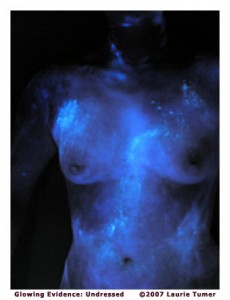 LT: I think the response has and continues to be very good. Glowing Evidence (the title of the series) was made for an art audience though, to my surprise, it became of interest to other audiences as well. I was invited to talk about it at the ECO-FARM conference in California, an environmental writers conference to honor Rachel Carson in Maine, and show photographs at MAGIC, the large fashion expo for buyers. The Texas Department of Health contacted me about using one of my images on a postcard to direct physicians to a website to take a questionnaire about what they knew and didn’t about pesticides. One Canadian physician uses images from the series in training programs to educate rural physicians to recognize pesticide poisoning so it is not confused with other diagnoses. I get frequents requests to use my work for publications of various kinds. In the last few years the work has become of interest to art critics and publishers in China where they are just waking up to their environmental predicament.
LT: I think the response has and continues to be very good. Glowing Evidence (the title of the series) was made for an art audience though, to my surprise, it became of interest to other audiences as well. I was invited to talk about it at the ECO-FARM conference in California, an environmental writers conference to honor Rachel Carson in Maine, and show photographs at MAGIC, the large fashion expo for buyers. The Texas Department of Health contacted me about using one of my images on a postcard to direct physicians to a website to take a questionnaire about what they knew and didn’t about pesticides. One Canadian physician uses images from the series in training programs to educate rural physicians to recognize pesticide poisoning so it is not confused with other diagnoses. I get frequents requests to use my work for publications of various kinds. In the last few years the work has become of interest to art critics and publishers in China where they are just waking up to their environmental predicament.
I would say the art audience is the one that has the hardest time wrapping their brains around the idea that we live in a world of invisible chemicals that are truly ubiquitous. I have had work in shows where art curators describe the work (in spite of my sending statements about it) in ways that show they obviously “missed the point” or they are unwilling to state what is truly about, even in shows that are about “the environment!”
 JG: I imagine it would be very disappointing to have colleagues miss the point, but also very gratifying to have caught the attention of people across such a wide spectrum of our culture. It’s really a genius concept – to make the invisible visible – because it seems to be human nature not to believe in what you can’t see. (Except, of course, when it comes to religion.) What other themes do you work with in your photography?
JG: I imagine it would be very disappointing to have colleagues miss the point, but also very gratifying to have caught the attention of people across such a wide spectrum of our culture. It’s really a genius concept – to make the invisible visible – because it seems to be human nature not to believe in what you can’t see. (Except, of course, when it comes to religion.) What other themes do you work with in your photography?
 LT: Glowing Evidence has many themes running through it: how visualizing the unseen can alter perception and behavior, it’s about health and safety, and it is about beauty. I believe it was David Levi Strauss in his book Between the Eyes: Essays on Photography and Politics who said of the photographer Lewis Hine who showed child labor in the U.S. that he wanted to show both “what was bad so we would oppose it and what was good so we would value it.” I think my intention is similar. view my latest projects here.
LT: Glowing Evidence has many themes running through it: how visualizing the unseen can alter perception and behavior, it’s about health and safety, and it is about beauty. I believe it was David Levi Strauss in his book Between the Eyes: Essays on Photography and Politics who said of the photographer Lewis Hine who showed child labor in the U.S. that he wanted to show both “what was bad so we would oppose it and what was good so we would value it.” I think my intention is similar. view my latest projects here.
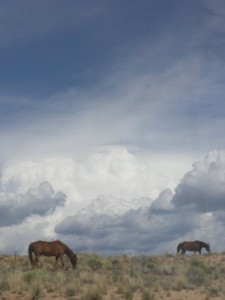
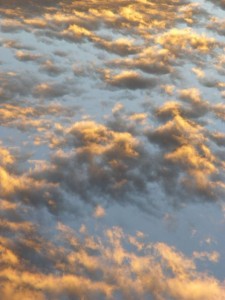
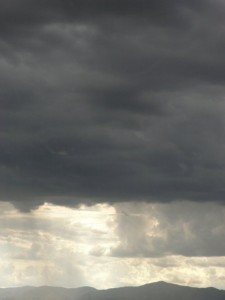
images from “I’d Rather Look at Clouds” series
I am currently working on a new series titled I’d Rather Look at Clouds. These photographs are all taken at my new home through the windows from my lounge chair! Partly the theme is fatigue – the fatigue of social conscience, the fatigue that comes from dealing with MCS, and the fatigue of chronic pain. Literally, I’d rather look at clouds. The theme is also about beauty.
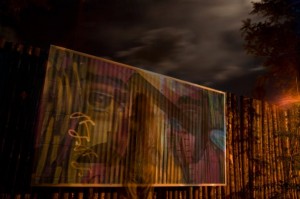
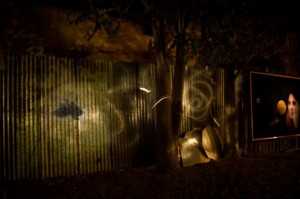
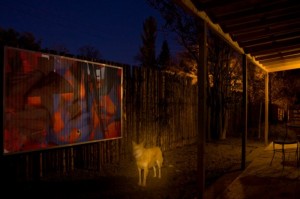
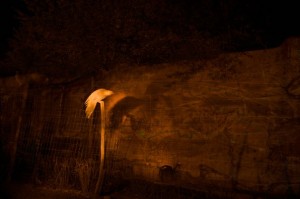
images from “Oil Exploration: Not in My Backyard” series
Last year I became an honorary member of a graffiti crew for a project I was invited to participate in to raise awareness about oil and gas drilling issues in New Mexico. A portfolio of images from the exhibition is now part of the art collection at the Palace of the Governors in New Mexico. I worked with my crew on the concepts and made the stencils but didn’t do the spraying of the paint! I’ll be teaching an online class later this year on the History of Graffiti through Santa Fe Community College in New Mexico. view graffiti project
 JG: I really love this latest series. I’ve heard about chemically sensitive people losing their homes in the Santa Fe area due to impending oil exploration plans. Where I live in Arizona, we are dealing with a similar problem but our issue is wind and solar farms which threaten to destroy the peace and security many of us with severe chemical and electrical intolerances have found in this very rural area. It’s amazing to me that you’ve been able to continue your work even with the chronic pain, fatigue, and other debilitating symptoms you live with every day. You are an inspiration! Thank you for sharing your amazing photography images and the stories behind them.
JG: I really love this latest series. I’ve heard about chemically sensitive people losing their homes in the Santa Fe area due to impending oil exploration plans. Where I live in Arizona, we are dealing with a similar problem but our issue is wind and solar farms which threaten to destroy the peace and security many of us with severe chemical and electrical intolerances have found in this very rural area. It’s amazing to me that you’ve been able to continue your work even with the chronic pain, fatigue, and other debilitating symptoms you live with every day. You are an inspiration! Thank you for sharing your amazing photography images and the stories behind them.
 Julie Genser is the founder of PlanetThrive.com, a hip, rockin’ community that aims to empower others healing from environmental illnesses with the information, resources, and support necessary to create change in their world.
Julie Genser is the founder of PlanetThrive.com, a hip, rockin’ community that aims to empower others healing from environmental illnesses with the information, resources, and support necessary to create change in their world.






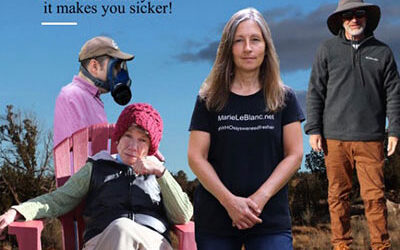
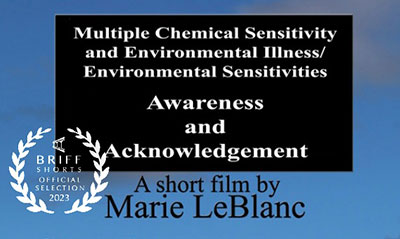
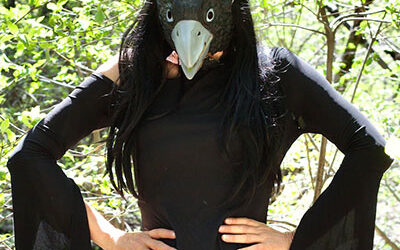
Great interview. I love Laurie’s work and enjoyed finding out more about it. I am a HUGE fan!!!
j8
I am chemically sensitive and realized it around 1989. I was diagnosed with breast cancer in 1993 and felt unable to tolerate chemotherapy. Because of that refusal I began to explore alternative medicine. I found so much I started a nonprofit that informs people with cancer about natural therapies.
It’s amazing where things bring us. In 1999 I started taking Chinese herbs to deal with recurrent breast cancer – I was also taking a ton of supplements, as well as acupuncture, applied kinesiology and osteopathy. The first herbal tea I drank created an immense hive attack ALL over my entire body. As it faded, over a three-day period, my level of intensity of chemical sensitivity reduced greatly as did the usual symptoms that I experienced.
I am still chemically sensitive but no longer subject to days or weeks of illness.
Hi Ann,
I just checked out your site and WOW! There’s a wealth of information there.
I was wondering what that herbal tea was that caused the hives?
thank you for all of the work you put into your website.
I love this site. It’s chock full of the human interest stories and unique angles that are often overlooked on other MCS blogs. Julie Genser reminds me of an MCS version of NPR’s Ira Glass. Thanks for keeping this site so rockin’ and hip!
Wow, Carrie, what a great compliment to wake up to! This made my day. ;-) I love doing this site, it is a real joy in my life and receiving positive feedback like yours just validates that I am on the right track. Thanks so much for stopping by and leaving a comment! xx Julie